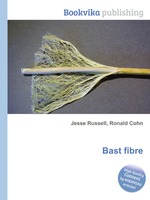Bast fibre
Jesse Russell Ronald Cohn
бумажная книга
High Quality Content by WIKIPEDIA articles! Bast fibre or skin fibre is plant fibre collected from the phloem (the "inner bark" or the skin) or bast surrounding the stem of certain, mainly dicotyledonous, plants. They support the conductive cells of the phloem and provide strength to the stem. Most of the technically important bast fibres are obtained from herbs cultivated in agriculture, as for instance flax, hemp, or ramie, but also bast fibres from wild plants, as stinging nettle, and trees such as lime or linden, have been used to some extent. Since the valuable fibres are located in the phloem, they must often be separated from the xylem material ("woody core"), and sometimes also from epidermis. The process for this is called retting, and can be performed by micro-organisms either on land (nowadays the most important) or in water, or by chemicals (for instance high pH and chelating agents) or by pectinolytic enzymes. In the phloem bast fibres occur in bundles that are glued together by pectin and calcium ions. More intense retting separates the fibre bundles into elementary fibres, that can be several centimetres long. Often bast fibres have higher tensile strength than other kinds, and are used in high-quality textiles (sometimes in blends with cotton or synthetic fibres), ropes, yarn, paper, composite materials and burlap. A special property of bast fibres is that they contain a special structure, the fibre node, that represents a weak point. Seed hairs, such as cotton, do not have nodes.


